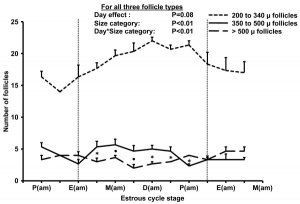Estrous Cycle: Difference between revisions
| Line 15: | Line 15: | ||
The estrous cycle is Polyoestrous with an estrous period of approximately 12 hours. | The estrous cycle is Polyoestrous with an estrous period of approximately 12 hours. | ||
'''Links:''' [[Rat Development]] | [http://www.ncbi.nlm.nih.gov/sites/entrez?db=pubmed&cmd=search&term=rat+estrous+cycle PubMed- rat estrous cycle] | '''Links:''' [[Rat Development]] | [[http://www.ncbi.nlm.nih.gov/pubmed/16195173 PMID: 16195173]] | [http://www.ncbi.nlm.nih.gov/sites/entrez?db=pubmed&cmd=search&term=rat+estrous+cycle PubMed- rat estrous cycle] | ||
==Mouse Estrous Cycle== | ==Mouse Estrous Cycle== | ||
Revision as of 21:37, 21 April 2010
Introduction
The estrous cycle (British spelling, oestrous) is the main reproductive cycle of other species females of non-primate vertebrates, for example rats, mice, horses, pig have this form of reproductive cycle. There are also a variety of different forms:
- Polyestrous Animals - Estrous cycles throughout the year (cattle, pigs, mouse, rat).
- Seasonally Polyestrous Animals - Animals that have multiple estrous cycles only during certain periods of the year (horses, sheep, goats, deer, cats).
- Monestrous Animals - Animals that have one estrous cycle per year (dogs, wolves, foxes, and bear)
Links: Estrous Cycle | Mouse Estrous Cycle | original page
Rat Estrous Cycle
One of the best characterised reproductive cycles, though different species of rats may differ in reproduction. In general, puberty occurs at 6-8 weeks when the oestrous cycle commences each cycle is 4-5 days.
The estrous cycle is Polyoestrous with an estrous period of approximately 12 hours.
Links: Rat Development | [PMID: 16195173] | PubMed- rat estrous cycle
Mouse Estrous Cycle
The mouse oestrus cycle is 4-6 days, with oestrus lasting less than 1 day. (More? Other Embryos- Mouse Estrous Cycle)
The oestrus cycle stops during lactation except for one oestrus 12-20 hours postpartum.
Determining the stage of the estrous cycle in the mouse by the appearance of the vagina.[1]
- Estrous Diestrus - Vagina has a small opening and the tissues are bluish-purple in color and very moist.
- Proestrus - Vagina is gaping and the tissues are reddish-pink and moist. Numerous longitudinal folds or striations are visible on both the dorsal and ventral lips.
- Estrus - Vaginal signs are similar to proestrus, but the tissues are lighter pink and less moist, and the striations are more pronounced.
- Metestrus-1 - Vaginal tissues are pale and dry. Dorsal lip is not as edematous as in estrus.
- Metestrus-2 - Vaginal signs are similar to metestrus-1, but the lip is less edematous and has receded. Whitish cellular debris may line the inner walls or partially fill the Vagina.
Links: Mouse Estrous Cycle
Pig Estrous Cycle
The feedback systems between the ovaries, uterus, hypothalamus and pituitary gland govern a cycle of events that takes 18-21 days. If conception occurs this cyclic pattern is interrupted and pregnancy is maintained for approximately 114 days. Removal of the sucking stimulus at weaning triggers a new sequence of events.
Links: Pig Development
References
- ↑ Determining the stage of the estrous cycle in the mouse by the appearance of the vagina. Champlin AK, Dorr DL, Gates AH. Biol Reprod. 1973 May;8(4):491-4. PMID: 4736343
Reviews
Articles
- Su P, Wu JC, Sommer JR, Gore AJ, Petters RM, Miller WL. [See Related Articles] Conditional induction of ovulation in mice. Biol Reprod. 2005 Oct;73(4):681-7.
- Champlin AK, Dorr DL, Gates AH. [See Related Articles] Determining the stage of the estrous cycle in the mouse by the appearance of the vagina. Biol Reprod. 1973 May;8(4):491-4.
Search Pubmed
Search Pubmed Now: Estrous Cycle | Oestrous Cycle
| Animal Development: axolotl | bat | cat | chicken | cow | dog | dolphin | echidna | fly | frog | goat | grasshopper | guinea pig | hamster | horse | kangaroo | koala | lizard | medaka | mouse | opossum | pig | platypus | rabbit | rat | salamander | sea squirt | sea urchin | sheep | worm | zebrafish | life cycles | development timetable | development models | K12 |
Glossary Links
- Glossary: A | B | C | D | E | F | G | H | I | J | K | L | M | N | O | P | Q | R | S | T | U | V | W | X | Y | Z | Numbers | Symbols | Term Link
Cite this page: Hill, M.A. (2024, April 19) Embryology Estrous Cycle. Retrieved from https://embryology.med.unsw.edu.au/embryology/index.php/Estrous_Cycle
- © Dr Mark Hill 2024, UNSW Embryology ISBN: 978 0 7334 2609 4 - UNSW CRICOS Provider Code No. 00098G
